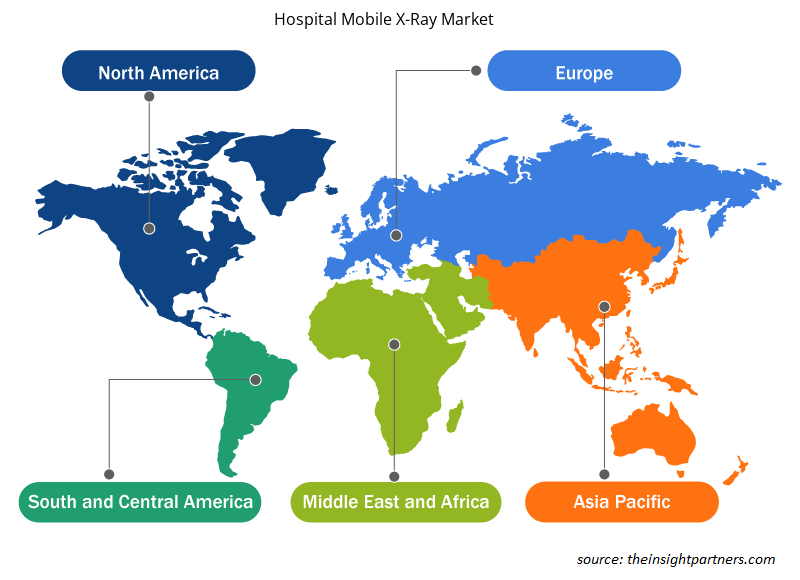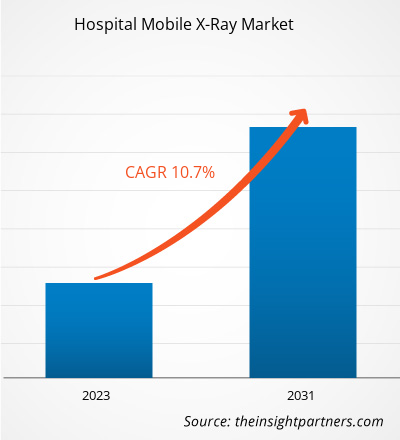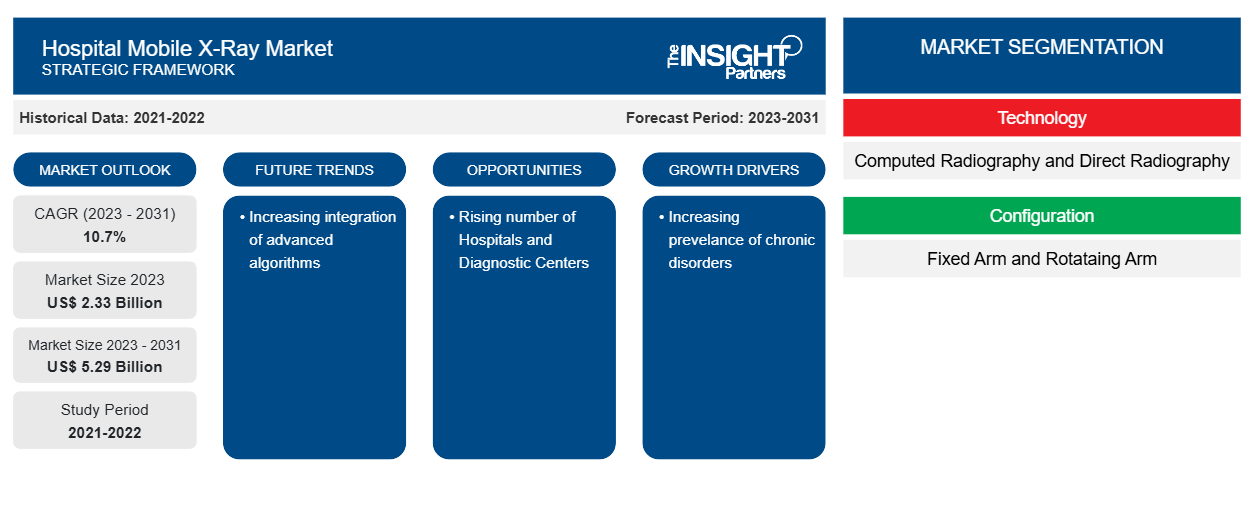Se prevé que el tamaño del mercado de rayos X móviles en hospitales alcance los 5290 millones de dólares en 2031, frente a los 2330 millones de dólares en 2023. Se espera que el mercado registre una CAGR del 10,7 % durante el período 2023-2031. Es probable que el creciente número de lanzamientos de productos y la creciente integración de algoritmos avanzados para obtener mejores imágenes sigan siendo tendencias clave en el mercado de rayos X móviles en hospitales.CAGR of 10.7% during 2023–2031. The increasing number of product launches and the rising integration of advanced algorithms for better imaging are likely to remain key trends in the hospital mobile X-ray market.
Análisis del mercado de equipos de rayos X móviles para hospitales
El crecimiento del mercado de rayos X móviles en hospitales está impulsado por la creciente prevalencia de trastornos crónicos y la creciente adopción de sistemas avanzados de rayos X móviles en hospitales. Ha habido un tremendo aumento en la prevalencia de trastornos crónicos, incluidos el cáncer, los trastornos cardiovasculares y los trastornos ortopédicos y musculoesqueléticos. Estas afecciones han afectado negativamente a grandes poblaciones a nivel mundial, lo que depreció la calidad de vida. Según la Organización Mundial de la Salud (OMS), en 2022, aproximadamente 1.71 mil millones de personas en todo el mundo se vieron afectadas por trastornos musculoesqueléticos. Un aumento en los lanzamientos de productos también impulsa el crecimiento del mercado.
Descripción general del mercado de equipos de rayos X móviles para hospitales
En los hospitales, los sistemas de rayos X móviles se utilizan para el diagnóstico de diversas enfermedades crónicas. Además, se espera que el creciente número de hospitales y centros de diagnóstico y la creciente integración de algoritmos avanzados para obtener mejores imágenes creen amplias oportunidades para el mercado de rayos X móviles en hospitales. Es probable que América del Norte represente la mayor participación de mercado durante el período de pronóstico. Se prevé que Asia Pacífico registre la CAGR más alta en los próximos años.CAGR in the coming years.
Personalice este informe según sus necesidades
Obtendrá personalización en cualquier informe, sin cargo, incluidas partes de este informe o análisis a nivel de país, paquete de datos de Excel, así como también grandes ofertas y descuentos para empresas emergentes y universidades.
- Obtenga las principales tendencias clave del mercado de este informe.Esta muestra GRATUITA incluirá análisis de datos, desde tendencias del mercado hasta estimaciones y pronósticos.
Factores impulsores y oportunidades del mercado de rayos X móviles en hospitales
Mayor adopción de rayos X móviles en hospitales favorecerá el mercado
La creciente adopción de sistemas de rayos X móviles avanzados ofrece beneficios a los médicos y a los pacientes. Uno de los principales beneficios de los sistemas es su capacidad para evitar movimientos y transportes adicionales de pacientes que padecen enfermedades graves. La mayoría de los sistemas de rayos X móviles están equipados con un soporte sobre ruedas, mientras que algunos sistemas están motorizados, lo que permite a los técnicos transportar el sistema de rayos X de forma fácil y rápida. Además, los sistemas de rayos X digitales móviles permiten la captura y el procesamiento rápidos de imágenes con la ayuda de un software intuitivo. Además, se puede acceder a los resultados en tiempo real y se pueden compartir directamente con el médico del paciente, lo que les ayuda a continuar con los procesos de tratamiento posteriores. En marzo de 2021, Fujifilm India Pvt. Ltd. lanzó su sistema de radiología digital móvil, FDR nano. El sistema ofrece imágenes de alta resolución con bajas dosis de rayos X en entornos sanitarios. Permite circuitos de reducción de ruido que mejoran la granularidad de las regiones de baja densidad y logran una alta calidad de imagen.Fujifilm India Pvt. Ltd. launched its mobile digital radiology system – FDR nano. The system offers high-resolution imaging with low X-ray doses in healthcare settings. It enables noise reduction circuits that improve the granularity of low-density regions and achieve high image quality.
Creciente número de hospitales y centros de diagnóstico
El sistema sanitario mundial ha experimentado un fuerte aumento de la industria del diagnóstico en los últimos años debido a la transformación de los sistemas sanitarios. Además, el rápido crecimiento de la población y la creciente prevalencia de enfermedades crónicas exigen una infraestructura de calidad entre los hospitales y los centros de diagnóstico. Según los datos recientes publicados por la Asociación Estadounidense de Hospitales, en 2024 hay casi 6.120 hospitales en Estados Unidos. Además, según los datos publicados por The Economic Times, en 2023 hay alrededor de 70.000 hospitales en la India. Además, estos hospitales de la India están haciendo hincapié en la adopción de tecnologías de diagnóstico portátiles para facilitar la obtención de imágenes médicas y proporcionar una mejor experiencia al paciente.
Análisis de segmentación del informe de mercado de equipos de rayos X móviles para hospitales
Los segmentos clave que contribuyeron a la derivación del análisis del mercado de rayos X móviles del hospital son la tecnología, la configuración y la sala.
- En términos de tecnología, el mercado de rayos X móviles en hospitales se divide en radiografía computarizada y radiografía directa. El segmento de radiografía computarizada tuvo una mayor participación de mercado en 2023.
- Por configuración, el mercado se divide en brazo fijo y brazo giratorio. El segmento de brazo fijo tuvo una mayor participación en el mercado en 2023.
- En términos de salas, el mercado de rayos X móviles en hospitales está segmentado en quirófanos, UCI y UCI neonatal, departamentos centrales de rayos X, departamentos de emergencia, salas de partos prematuros y otros. El segmento de quirófanos dominó el mercado en 2023.
Análisis de la cuota de mercado de los equipos de rayos X móviles para hospitales por geografía
El alcance geográfico del informe del mercado de rayos X móviles del hospital se divide principalmente en cinco regiones: América del Norte, Asia Pacífico, Europa, Medio Oriente y África, y América del Sur y Central.
América del Norte dominó el mercado de rayos X móviles para hospitales. El crecimiento del mercado en la región se atribuye a la creciente prevalencia de enfermedades crónicas, los desarrollos estratégicos de los actores del mercado y el creciente turismo médico en México que demanda dispositivos médicos avanzados y rentables para fines de diagnóstico y tratamiento. Además, debido al alto gasto en I+D para nuevas tecnologías y la presencia de actores del mercado global, América del Norte domina el mercado global de rayos X móviles para hospitales. Se prevé que Asia Pacífico registre la CAGR más alta en los próximos años.CAGR in the coming years.
Perspectivas regionales del mercado de rayos X móviles en hospitales
Los analistas de Insight Partners explicaron en detalle las tendencias y los factores regionales que influyen en el mercado de rayos X móviles para hospitales durante el período de pronóstico. Esta sección también analiza los segmentos y la geografía del mercado de rayos X móviles para hospitales en América del Norte, Europa, Asia Pacífico, Oriente Medio y África, y América del Sur y Central.

- Obtenga datos regionales específicos para el mercado de rayos X móviles en hospitales
Alcance del informe sobre el mercado de equipos de rayos X móviles para hospitales
| Atributo del informe | Detalles |
|---|---|
| Tamaño del mercado en 2023 | US$ 2.33 mil millones |
| Tamaño del mercado en 2031 | 5.29 mil millones de dólares estadounidenses |
| CAGR global (2023 - 2031) | 10,7% |
| Datos históricos | 2021-2022 |
| Período de pronóstico | 2023-2031 |
| Segmentos cubiertos | Por tecnología
|
| Regiones y países cubiertos | América del norte
|
| Líderes del mercado y perfiles de empresas clave |
|
Densidad de actores del mercado de equipos de rayos X móviles para hospitales: comprensión de su impacto en la dinámica empresarial
El mercado de equipos de rayos X móviles para hospitales está creciendo rápidamente, impulsado por la creciente demanda de los usuarios finales debido a factores como la evolución de las preferencias de los consumidores, los avances tecnológicos y una mayor conciencia de los beneficios del producto. A medida que aumenta la demanda, las empresas amplían sus ofertas, innovan para satisfacer las necesidades de los consumidores y aprovechan las tendencias emergentes, lo que impulsa aún más el crecimiento del mercado.
La densidad de actores del mercado se refiere a la distribución de las empresas o firmas que operan dentro de un mercado o industria en particular. Indica cuántos competidores (actores del mercado) están presentes en un espacio de mercado determinado en relación con su tamaño o valor total de mercado.
Las principales empresas que operan en el mercado de rayos X móviles para hospitales son:
- Grupo Agfa-Gevaert
- SEDECAL
- IMÁGENES MÉDICAS IDETEC
- Philips NV, la línea Koninklijke
- SternMed GmbH
- Imágenes DMS
Descargo de responsabilidad : Las empresas enumeradas anteriormente no están clasificadas en ningún orden particular.

- Obtenga una descripción general de los principales actores clave del mercado de rayos X móviles en hospitales
Noticias y desarrollos recientes del mercado de equipos de rayos X móviles para hospitales
El mercado de equipos de rayos X móviles para hospitales se evalúa mediante la recopilación de datos cualitativos y cuantitativos posteriores a la investigación primaria y secundaria, que incluye publicaciones corporativas importantes, datos de asociaciones y bases de datos. A continuación, se enumeran algunos de los desarrollos en el mercado de equipos de rayos X móviles para hospitales:
- La empresa lanzó en Japón AeroDR TX m01, un sistema de rayos X móvil con una función de radiografía digital dinámica inalámbrica. El sistema permite realizar radiografías dinámicas además de radiografías estáticas convencionales sin tener que trasladar al paciente a una sala de rayos X , lo que ayuda a proporcionar el tratamiento adecuado y a prevenir el agravamiento de los síntomas. (Fuente: Konica Minolta, Inc., comunicado de prensa/sitio web de la empresa 2022)
- La empresa lanzó su sistema de rayos X móvil digital MobileDaRt Evolution MX8 versión v en la Reunión y Exposición Anual de la Asociación Estadounidense de Administradores de Radiología Sanitaria (AHRA), celebrada en Phoenix, EE. UU. Está equipado con GLIDE Technologies, una asistencia motorizada patentada que permite un funcionamiento suave y ágil en curvas cerradas. Hasta la fecha, para adaptarse a las instalaciones médicas, la empresa ha proporcionado tres tipos de unidades DR con diferentes tipos de detectores de rayos X digitales (FPD: detector de panel plano) y un sistema digital integrado. (Fuente: Shimadzu Corporation, comunicado de prensa/sitio web de la empresa 2022)
- La empresa lanzó su Mobilett Impact en el Congreso Europeo de Radiología (ECR) en Viena. El sistema combina todos los beneficios de un sistema de rayos X móvil para realizar imágenes junto a la cama del paciente con una integración digital completa y un precio económico. Con Mobilett Impact, no solo se puede realizar la toma de imágenes en sí, sino todo el flujo de trabajo de toma de imágenes junto a la cama del paciente. (Fuente: Siemens Healthineers AG, comunicado de prensa/sitio web de la empresa 2022)
Informe de radiología móvil del hospital: cobertura y resultados
El informe “Tamaño y pronóstico del mercado de rayos X móviles en hospitales (2021-2031)” proporciona un análisis detallado del mercado que cubre las siguientes áreas:
- Tamaño del mercado de rayos X móviles en hospitales y pronóstico a nivel global, regional y nacional para todos los segmentos clave del mercado cubiertos bajo el alcance
- Tendencias del mercado de rayos X móviles en hospitales, así como dinámica del mercado, como impulsores, restricciones y oportunidades clave
- Análisis detallado de las cinco fuerzas de Porter y PEST y FODA
- Análisis del mercado de rayos X móviles en hospitales que abarca las tendencias clave del mercado, el marco global y regional, los principales actores, las regulaciones y los desarrollos recientes del mercado
- Panorama de la industria y análisis de la competencia que abarca la concentración del mercado, análisis de mapas de calor, actores destacados y desarrollos recientes para el mercado de rayos X móviles en hospitales
- Perfiles detallados de empresas
- Análisis histórico (2 años), año base, pronóstico (7 años) con CAGR
- Análisis PEST y FODA
- Tamaño del mercado, valor/volumen: global, regional y nacional
- Industria y panorama competitivo
- Conjunto de datos de Excel
Informes recientes
Informes relacionados
Testimonios
Razón para comprar
- Toma de decisiones informada
- Comprensión de la dinámica del mercado
- Análisis competitivo
- Información sobre clientes
- Pronósticos del mercado
- Mitigación de riesgos
- Planificación estratégica
- Justificación de la inversión
- Identificación de mercados emergentes
- Mejora de las estrategias de marketing
- Impulso de la eficiencia operativa
- Alineación con las tendencias regulatorias























 Obtenga una muestra gratuita para - Mercado de rayos X móviles para hospitales
Obtenga una muestra gratuita para - Mercado de rayos X móviles para hospitales